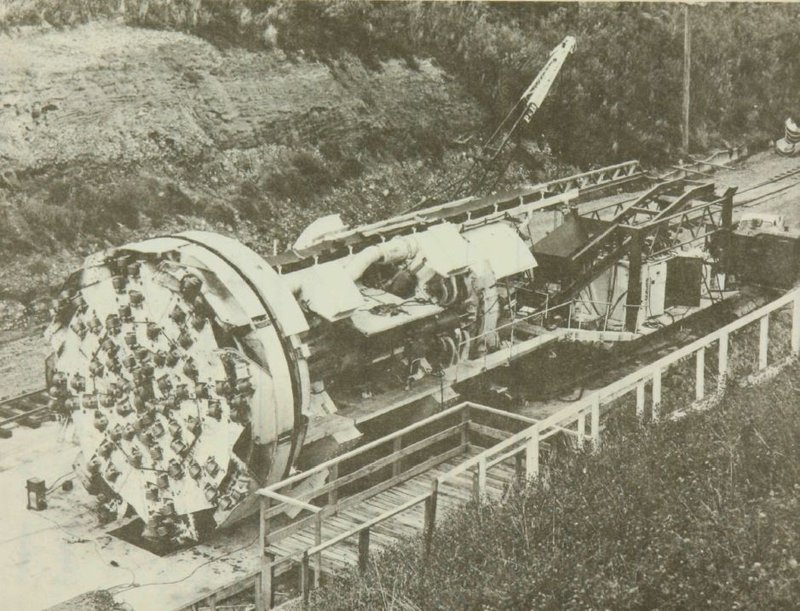Opened in 1978, the Kaimai tunnel provides an important rail link between the Waikato and the Port of Tauranga.
Desperately needed
The operation of the Kinleith paper mill in the early 1950s greatly increased rail traffic in the Bay of Plenty. To reach the port at Mt Maunganui, timber and paper products from the mill travelled by rail north to Paeroa via Matamata before rounding the top of the Kaimai range where they could then head south via Waihī to Tauranga.
A tunnel through the Kaimai range would shave over 85km off the journey. There was much agitation for the tunnel’s construction and in 1962 the Government set up a commission of inquiry to assess the proposal. The commission found in favour and the Government approved the kaimai deviation in 1964. Physical works started the following year.

The Tunnel Boring Machine. Transactions of the New Zealand Institution of Engineers, Vol. 5, No. 1, Jun 1978, p60
Challenge and tragedy
At 8.9km, the Kaimai Tunnel is New Zealand’s longest railway tunnel. The geology of the Kaimai Range presented a number of challenges and the project was described as one of the most difficult civil engineering projects yet undertaken. It was also the first project in New Zealand to use a ‘full face hard rock’ Tunnel Boring Machine (TBM).
The project was designed and constructed for the New Zealand Railways by the Ministry of Works and Development. Work began on the Kaimai railway deviation in 1965 and excavation work on the tunnel was underway by 1969. Excavation took six and a half years.
The Kaimai Range is part of a major volcanic block. Geological surveys had indicated a stratified sequence of andesitic lavas and overlying ignimbrites.
Excavation began on the west side of the range through loose alluvial material. Once andesite was reached the TBM was brought in. However, the andesite was very broken, making progress slow, difficult and expensive.
In the early stages of construction, a disastrous cave-in occurred, trapping 12 workers. Eight of the men were rescued, but four lost their lives. A plaque near the western end of the tunnel commemorates the men who died.
The TBM was then moved to the eastern side of the range where it was put to work cutting through ignimbrite. This rock was softer and had fewer joins. Daily progress varied greatly but averaged about 25 metres per week.
Meanwhile, slow manual progress continued on the western side. Due to geothermal heating, rock temperatures reached 38 degrees Celsius. Refrigeration plants were installed, and shifts limited to six hours.
The project provided an extreme range of tunnelling conditions and there was even, in one section, signs of an ancient buried forest encased in lava estimated to be 4 million years old.
The TBM completed about half the tunnel's excavation. It was considered to have been marginally successful, but more than anything it provided valuable experience for other projects involving large scale machine tunnelling.
The tunnel was formally opened by Prime Minister Robert Muldoon on 12 September 1978.
An important piece of infrastructure
The Kaimai tunnel remains an important piece of infrastructure, providing a rail link to the Port of Tauranga. Approximately 20 freight trains carrying timber and manufactured goods run through the tunnel each day.
Over the years, groundwater damaged sections of the subgrade under the tunnel floor. In 2018-2019, KiwiRail worked with Mainmark to re-level the rail slab. Resin was injected to fill voids beneath the rail line to support the slab and lift the track back to its original level.
Between 2015 -2018, Fulton Hogan completed upgrade work on the tunnel. This work included the installation of a new communications system, installation of a new track support pad, tunnel ventilation improvement, tunnel cleaning, track slab repairs and installation of new side drain covers.
More Information
Further reading
Bennion, John D. “The Kaimai Tunnel: Excavation and lining.” Transactions of the New Zealand Institution of Engineers, Vol. 5, No. 1, (June 1978): 35-60.
Hegan, B. D. "Kaimai Tunnel: a Geological Section through an Ancient Volcano." In: Geotechnics on the Volcanic Edge: Tauranga, March 2003, New Zealand Geotechnical Society Symposium. Wellington, N.Z.: Institution of Professional Engineers New Zealand, 2003: 65-70.
Scott, Bob. Kaimai: The story of the Kaimai tunnel and the East Coast Main Trunk Railway. Wellington: Southern Press in association with New Zealand Railways, 1978.
Read more about the 2015-2019 tunnel repairs.
Location
Kaimai tunnel
Entry by L. W. Jones
Page last updated 31 October 2022
